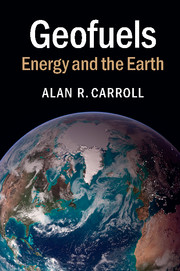Book contents
- Frontmatter
- Contents
- Acknowledgments
- 1 Introduction
- 2 The Living Earth
- 3 Warmed from Above: Solar Energy
- 4 Wind, Water, and Waves: Energy from the Fluid Earth
- 5 Covered in Green: Biofuels Basics
- 6 Fossil Farming: The Geologic Underpinnings of Biofuels
- 7 The Light of an Ancient Sun: Fossil Fuel Origins
- 8 Digging for Daylight: Coal and Oil Shale
- 9 Skimming the Cream: Conventional Oil and Gas
- 10 Stuck in the Mud: Fossil Fuels That Fail to Flow
- 11 Petrified Petroleum: Oil Sand and Gas Hydrate
- 12 Water, Water, Everywhere
- 13 Primordial Power: Geothermal and Nuclear
- 14 Out of Sight, Out of Mind: Geologic Waste Disposal
- 15 How Long Is Forever? Energy and Time
- 16 Conclusions
- Index
- References
11 - Petrified Petroleum: Oil Sand and Gas Hydrate
Published online by Cambridge University Press: 05 March 2015
- Frontmatter
- Contents
- Acknowledgments
- 1 Introduction
- 2 The Living Earth
- 3 Warmed from Above: Solar Energy
- 4 Wind, Water, and Waves: Energy from the Fluid Earth
- 5 Covered in Green: Biofuels Basics
- 6 Fossil Farming: The Geologic Underpinnings of Biofuels
- 7 The Light of an Ancient Sun: Fossil Fuel Origins
- 8 Digging for Daylight: Coal and Oil Shale
- 9 Skimming the Cream: Conventional Oil and Gas
- 10 Stuck in the Mud: Fossil Fuels That Fail to Flow
- 11 Petrified Petroleum: Oil Sand and Gas Hydrate
- 12 Water, Water, Everywhere
- 13 Primordial Power: Geothermal and Nuclear
- 14 Out of Sight, Out of Mind: Geologic Waste Disposal
- 15 How Long Is Forever? Energy and Time
- 16 Conclusions
- Index
- References
Summary
The preceding chapters described mobile, naturally concentrated hydrocarbon fuels (Chapter 9) and relatively immobile hydrocarbons that remain “stuck” near their source (Chapter 10). There is yet a third category that must be added to complete this list: oil and gas that successfully escape their source beds but then lose their mobility as they approach the Earth's surface. They now lie imprisoned, condemned to a monotonous and indefinite existence in one of two forms: thickened crude oil that has ceased to flow, or natural gas frozen into an exotic form of ice. Superficially these two could not appear more different; thickened crude is sticky and dark, whereas gas hydrate is crumbly and white. However, they share an acquired immobility. Rather than flowing through their host rock these deposits have become a part of it. They may reasonably be considered “petrified” oil and gas.
Thickened crude oil and gas hydrate both owe their existence to the intervention of microorganisms. Remarkable as it may seem, the petrification of crude oil results primarily from scavenging by specialized microbes that eat hydrocarbons. These microbes fall within two different groups of organisms that evolved billions of years ago: bacteria and archaea. The first group breathes oxygen (or sulfate, SO42-) and is responsible for most of the decay that normally inhibits the geologic preservation of dead organic matter (see Chapter 7). The second group includes methanogens, microbes that live off the organic remains left behind after bacterial decay. They earn their name by emitting methane as a by-product. Unlike the aerobic bacteria that started the job, methanogens operate entirely without oxygen and in fact cannot tolerate its presence. They are among the earliest inhabitants of Earth, having evolved before the atmosphere contained free oxygen. By necessity they now hide from the light of day, buried in oxygen-depleted sediment beneath mires or the ocean, or within our own lower digestive tracts.
- Type
- Chapter
- Information
- GeofuelsEnergy and the Earth, pp. 215 - 236Publisher: Cambridge University PressPrint publication year: 2015



